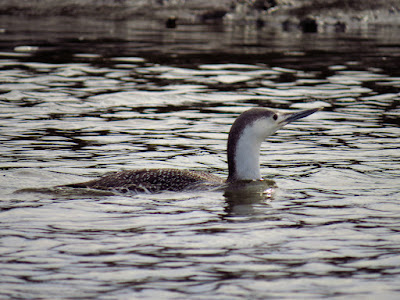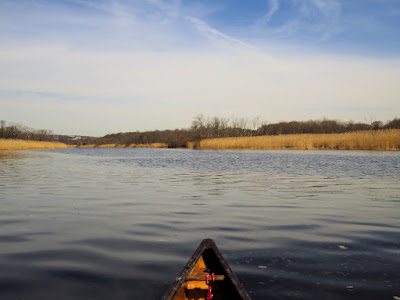Frequently visiting the same collection of coastal rivers, I have noticed that I will find certain birds in one river, but not another. Today, I put in on the East River in part because I am very likely to see a Red Throated Loon. The Red Throated Loon supposedly winters in this area, although I can't recall ever seeing one in the winter. But, when spring comes, I can be almost guaranteed to see at least one in the East River. Why here, I can't exactly say. I think I have only seen one in the Housatonic, even though the mouths of both rivers are salt marshes. In fact, if I want to see Common Loons, the Housatonic River is the place - I spotted twelve Common Loons on my last trip there. There may or may not be any science to it. It might just be that I prefer to canoe in the places where those birds prefer to swim.
As I am loading the canoe, a Red Throated Loon swims past. Speak of the devil. It is low tide with not much current, not much wind, not much sun, and not much of a chill. I spot a second Red Throated Loon at the second bend up river. After herding it up river for a couple hundred yards, it circles wide around me and resumes fishing in the area where I first saw it. I find a third Red Throated Loon at Cedar Island. It swims up river ahead of me and joins up with a fourth Red Throated Loon. There are some Buffleheads, and Gulls around as well.I continue on up past the stone arch bridge with not much else to report other than it being a fine day for a paddle. With the low tide, this is a good spot to turn back. Rounding the first turn of the Big Bends, I spot a coyote just three canoe lengths away. It is wet and looks to have just shook itself after swimming the short length across the river. It looks at me, lopes a few yards, looks back, and then disappears into the marsh.
Near Cedar Island, I am watching a Hawk when it flies over to one of the empty Osprey nest platforms and joins a second Hawk that is already there. a few hundred yards off, I use my camera to get a closer look - Osprey. I did not expect Osprey quite yet. I start paying attention and find four more as I head out.
A good wildlife count for the day - 4 Red Throated Loons, 6 Osprey, and a coyote.















